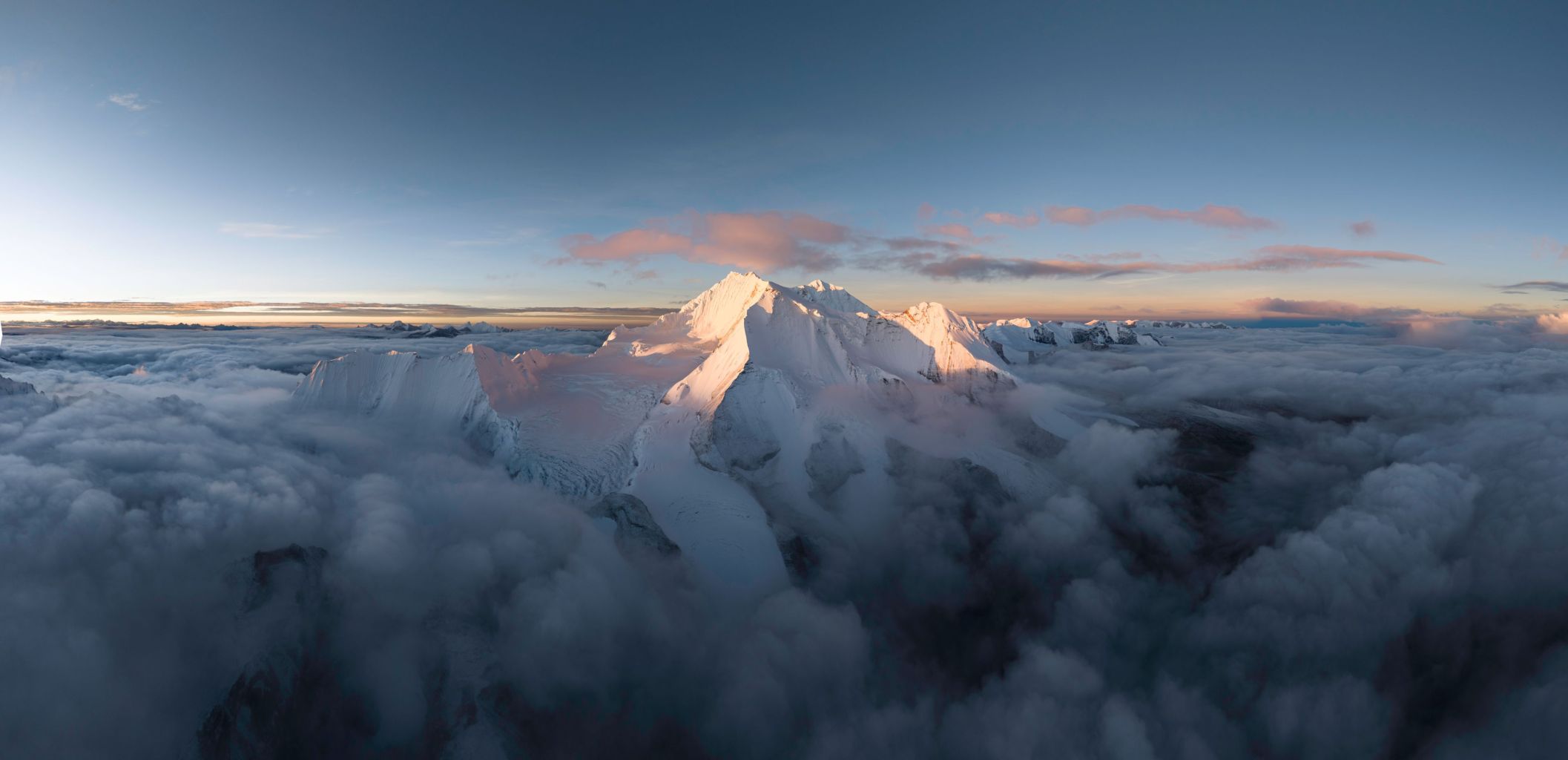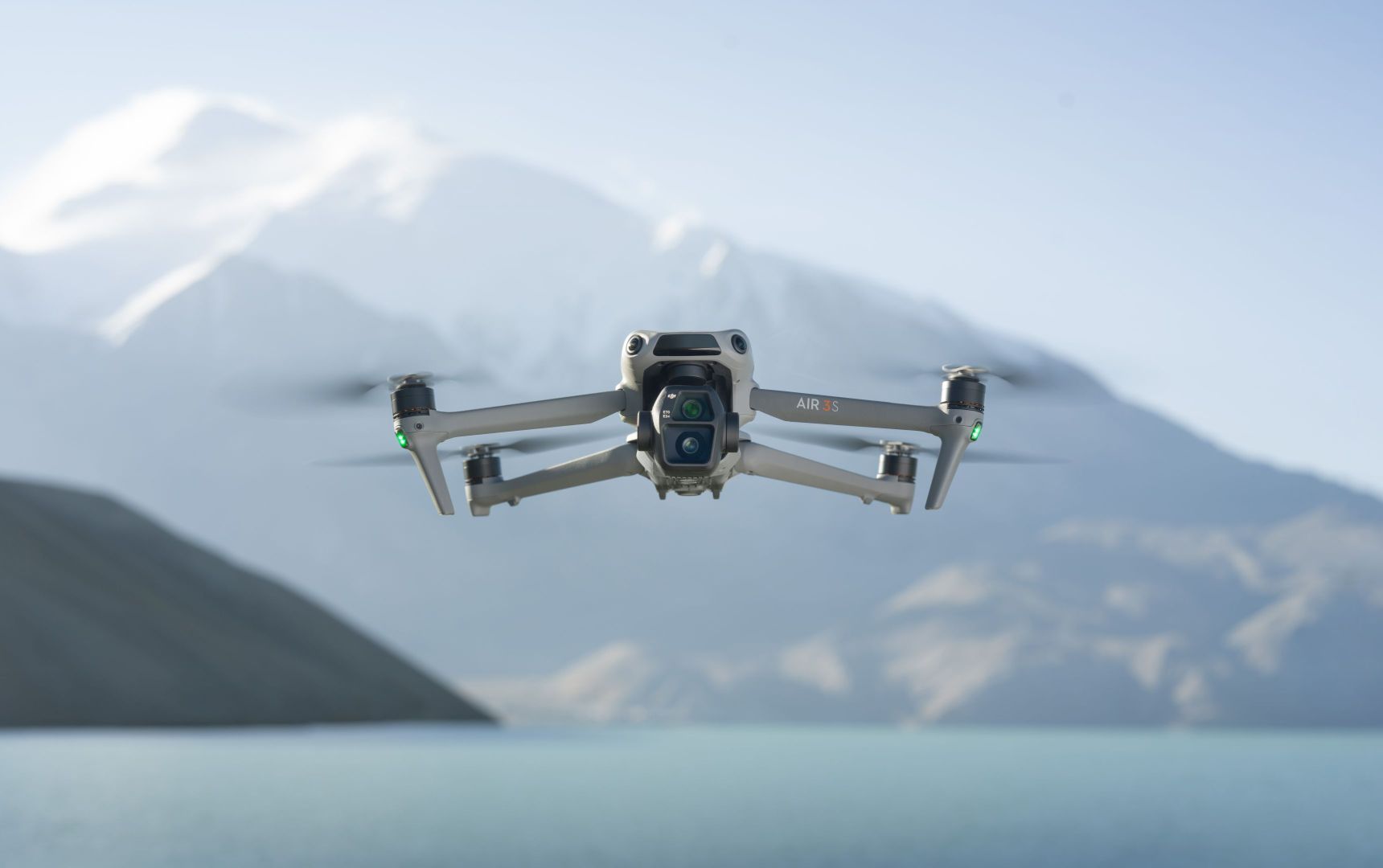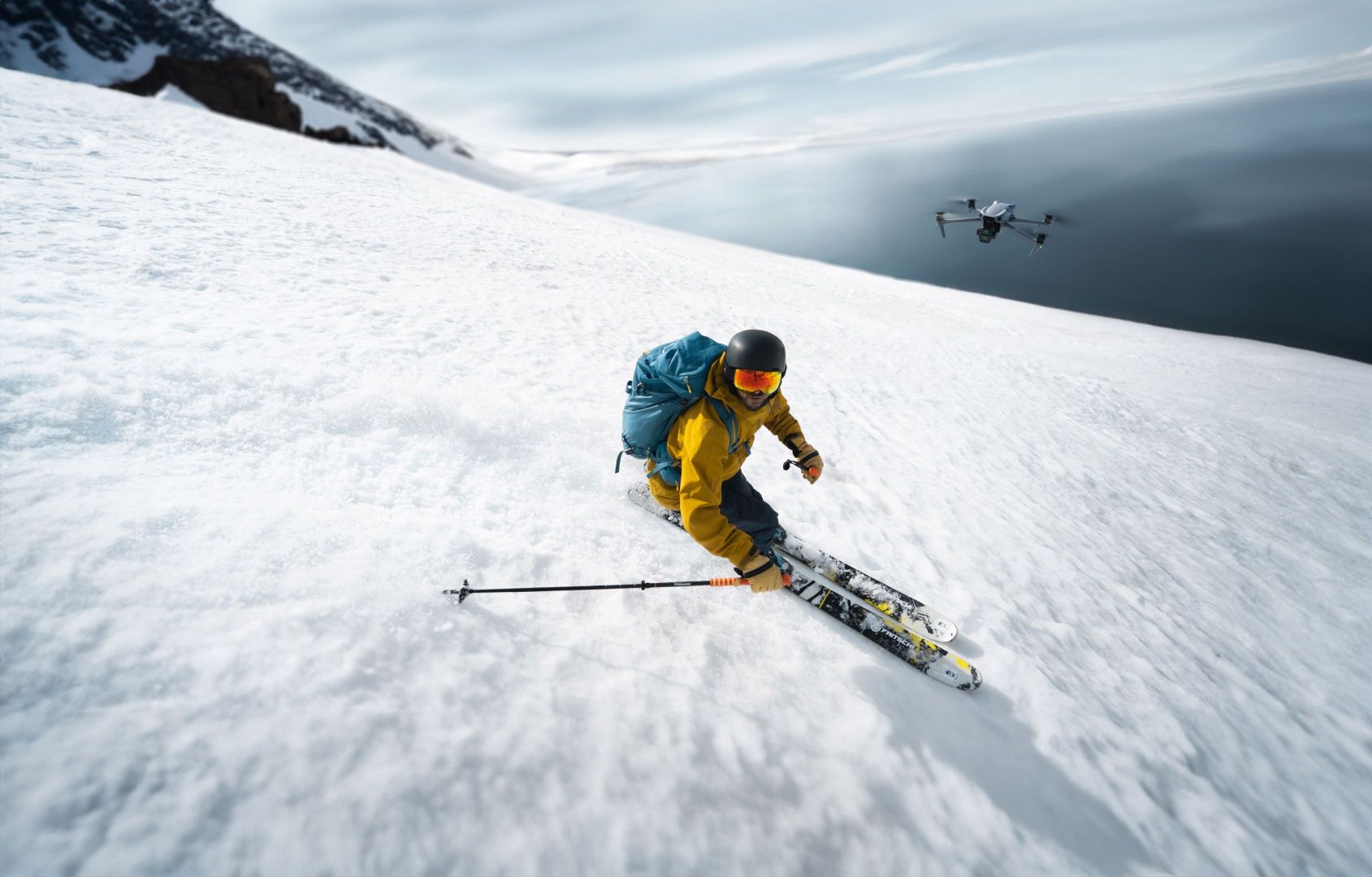Dual camera drone for travel
DJI Air 3S
Don't let the moment slip away

Designed for travel, the DJI Air 3S dual-camera drone incorporates a range of advanced technologies. The Air 3S's primary camera, equipped with a 1-inch CMOS sensor, and its 70mm medium telephoto lens camera[1] both have a dynamic range of up to 14 EV, capturing landscapes, portraits and other subjects in stunning detail. Both cameras support the new Free Panorama feature, which allows for flexible image range selection. For enhanced night photography safety, new features such as Night Obstacle Detection[2] and next-generation Smart RTH (Smart Return to Home) help you get the most out of every moment in the air.
Two cameras, unrivalled imaging
The DJI Air 3S features a dual camera system consisting of a 1-inch CMOS-sensor primary camera and a 1/1.3-inch CMOS-sensor medium telephoto camera. The primary camera has a larger CMOS sensor and a 24mm lens, making it ideal for capturing clearer, wide-angle views of larger landscapes. The 70mm medium telephoto camera is ideal for portraits and car shots, as it has a compressed depth of field, highlighting the subject with a bolder, more cinematic look.
1-inch CMOS primary camera: breathtaking detail for travel
The primary camera on the DJI Air 3S features a 50-megapixel, 1-inch CMOS sensor that supports 4K/60fps HDR and 4K/120fps video recording[6], as well as 10-bit D-Log M colour mode. Equipped with advanced image processing technology and intelligent algorithms, this large sensor captures the finest details even in low-light conditions such as sunsets and night landscapes, making it easy to capture breathtaking shots with ease.
Even better imaging, stunning landscapes
4K/60fps HDR video
The latest HDR video mode offers a dynamic range of up to 14 EV[1] and captures movie-like footage in high-contrast situations, such as sunrise or sunset, preserving the detail of cloud textures and other elements.
4K/120fps video[6]
The increased resolution and frame rate gives a vivid perspective to cultural and sporting events and creates exciting creative editing possibilities.
10-bit D-Log M and HLG video
The Air 3S can also record 10-bit H.265 encoded video in standard colour mode, providing refined colour performance and greater flexibility for post-production, and a maximum ISO of 12800. In D-Log M and HLG colour modes, the maximum ISO has been increased to 3200 for greater brightness and detail in night-time urban shots.
Medium telephoto camera: unforgettable portraits
With its 48 megapixel, 1/1.3-inch CMOS sensor, the medium telephoto camera supports the same video specifications and colour modes as the primary camera. This ensures visually consistent footage for easier post-production. A 70mm lens provides 3× optical zoom, so you can capture unique shots from a distance while highlighting your subject. With Air 3S, you can walk around a subject or person and capture detailed, expressive close-up portraits of them in up to 4K resolution video.
Focus on the details and make the most of the focal power
4K/60fps HDR video
When capturing close-ups of cars at sunset, the medium telephoto camera offers a dynamic range of up to 14 EV[1], allowing you to capture the rich colours of the setting sun in vibrant images.
4K/120fps HDR video[6]
When you're skiing in 4K/120fps slow-motion, the medium telephoto camera captures high-definition slow-motion video, so you can show off your skiing skills and the finest moves.
10-bit D-Log M and HLG video
The Air 3S's medium telephoto camera can also record 10-bit H.265 encoded video in standard colour mode, offering refined colour performance and greater flexibility for post-production. When 10-bit D-Log M mode is on, the camera captures detailed footage with richer colours and beautifully reproduces vibrant city lights as night falls.

Free panorama
The DJI Air 3S's primary camera and medium telephoto camera both have a Free Panorama mode, which lets you stitch together multiple images to create smoothly stitched panoramic shots of a manually selected subject or area. The wide-angle camera offers a wider field of view, giving you greater efficiency when taking panoramic photos. The medium telephoto camera significantly reduces image distortion, allowing you to capture masterful wide-angle shots from multiple photos, and the benefits of focal length allow you to capture detailed images.
The DJI Air 3S also supports popular features such as 2.7K vertical shots, MasterShots, QuickShots or Hyperlapse, giving the small drone a huge creative toolbox.
Safer night flying, more creativity
All-directional visual detection system
The DJI Air 3S drone supports Advanced Pilot Assistance Systems (APAS). In addition, the Air 3S is the first DJI drone to be equipped with forward-facing LiDAR sensors, downward-facing ToF (Time of Flight) infrared sensors and six visual sensors (two in front, two in back, two below), enabling night obstacle detection in all directions. [2] The feature allows the drone to automatically detect and avoid obstacles such as buildings on the flight and return path, so it can take photos at night with maximum safety.
Obstacle detection in all directions at night
New generation intelligent return (Smart RTH)
Non-GPS-based return
In good lighting conditions, DJI Air 3S uses real-time visual positioning and map generation technologies to remember your flight path. This allows for safe return even when taking off from a place where there is no satellite signal, such as a balcony.[7]
Return at night
The DJI Air 3S can use forward-facing LiDAR to detect obstacles such as tall buildings and lift off near them even in low-light conditions,[7] allowing for safer returns at night.
Improved Vision Assist backup cameras
In addition to front, rear, left and right views, the DJI Air 3S Vision Assist also provides a downward view to give the pilot a better overview of the drone's environment.
In addition to other advanced features, the DJI Air 3S also features Waypoint Flight and Cruise Control, which allow you to pre-set flight paths and camera movements, as well as quickly record stick control actions so the pilot can focus on creative functions.
ActiveTrack 360° for easy-to-access visual impact
New aerial aesthetics
The DJI Air 3S features ActiveTrack 360°, so you can keep any subject in the field of view optimally. Based on the flight environment, it automatically plans the flight path and adjusts camera compositions to create more powerful shots that keep the subject in focus.
ActiveTrack 360°
ActiveTrack 360° allows the Air 3S to automatically avoid crowded background perspectives.
Optimised object tracking
Once tracking begins, the DJI Air 3S can keep the subject in focus even when the lower half of the body is partially obscured by bushes or the figure is standing on a bridge.
Always in focus
The DJI Air 3S also includes a new feature: subject focusing keeps a subject or shape in sharp focus at all times, even during manual flight or when the shape leaves the centre of the field of view. The feature allows the drone pilot to focus fully on more creative aspects of the shot, such as composition and camera movement.
Increased flight and data transmission distance
Serious flight time: up to 45 minutes[3]
The Air 3S has a flight time of up to 45 minutes[3], enough time to scout locations, plan compositions, take shots and even reshoot.
10-bit O4 video transmission
Featuring DJI O4 FHD video transmission technology, the Air 3S provides 10-bit 1080p/60fps video transmission at up to 20 kilometres (12.5 miles).[4] Live streaming is reliably smooth and vivid, and the highly responsive control provides a better overall flight experience.
Compatible with DJI Cellular Dongle 2
For a seamless integration, the DJI Cellular Dongle 2[8] can be inserted directly into the DJI Air 3S without any additional accessories. If the O4 signal is obstructed or interfered with by any external factor, stable video transmission and drone control is provided via a 4G connection, increasing flight safety and reducing the risk of connection interruption.

We pay attention to detail
Always ready: 42 GB of built-in storage
The DJI Air 3S comes standard with 42 GB of built-in storage. This allows you to start shooting immediately, without having to bother with microSD cards.
QuickTransfer even when switched off
You can now send files from your Air 3S to a smartphone even when the drone is turned off.[9] Transfer to a computer can be done even when the drone is turned off by simply connecting the Air 3S via a compatible USB cable.
Battery charging centre with energy storage function[10]
The Battery Charging Centre supports PD fast charging and an energy accumulation feature that allows the remaining energy of several lower charge batteries to be transferred to the highest charge battery.[10]
Tailored to your needs
The DJI Air 3S is available in different product bundles and with a variety of accessories to suit all needs.
DJI Air 3S (DJI RC-N3)
Includes the standard DJI RC-N3 remote control. You can monitor the live video feed and flight status on your smartphone.
DJI Air 3S Fly More Combo (DJI RC-N3)
Includes the DJI RC-N3 remote control, an ND filter kit, two additional batteries, a battery charging centre, a shoulder bag and more.
DJI Air 3S Fly More Combo (DJI RC 2)
It includes the DJI RC 2 with a 5.5-inch, 1080p, 700-nite, high-brightness screen, an ND filter kit, two additional batteries, a battery charging center, a shoulder bag and more.
Note:
- In Auto mode, a dynamic range of 14 EV is available for video, but not for vertical or slow-motion.
- To enable all-direction night obstacle detection, there must be distinct textured surfaces in front of, behind, to the right and left of, and above the drone with illumination greater than 1 lux. Likewise, the ground below must be textured and diffuse reflective with a reflectivity above 20% (e.g. walls, trees or people) and illumination greater than 1 lux. DO NOT fly the drone in poor weather conditions, such as strong winds (12 m/s or more), snow, rain, lightning or fog. DO NOT fly the drone at altitudes above 6000 m (6,000 ft) above sea level. DO NOT fly the drone in an environment with temperatures below -10 °C or above +40 °C. DO NOT fly the drone from moving objects such as cars or boats. DO NOT fly the drone near reflective surfaces such as water or snow. Otherwise, the visual detection system may not function properly. If the GNSS signal is weak, fly the drone in a well-lit environment: in front of, behind, to the right and left of, and above the drone, there should be distinct textured surfaces with illumination greater than 10 lux. Likewise, the ground below should be textured and diffuse reflective, with a reflectivity of over 20%, and illumination greater than 10 lux. The visual perception system may not function properly in dimly lit environments. DO NOT fly near interfering magnetic or radio signal sources. Interfering magnetic or radio signal sources may include Wi-Fi hotspots, routers, Bluetooth devices, high voltage power lines, large transformer stations, radar stations, mobile base stations and transmission towers. If you're flying in a desert or coastal area, make sure you don't get sand inside the drone. Fly the drone in an open area, away from crowds. Buildings, mountains and trees can obscure the GNSS signal and interfere with the on-board compass.
- The flight time of the DJI Air 3S was measured flying forward at a constant speed of 32.4 km/h in a calm environment at sea level, with the automatic obstacle avoidance system set to brake, in photo mode, from 100% battery charge to 0% battery discharge. Data is for information only. Always pay attention to the warning messages in the app during flight.
- Testing was conducted in an open, outdoor environment without interfering signal sources and in compliance with FCC regulations. The above data represent the furthest communication range for one-way, non-reentry flights. Always listen for warning messages in the application during flight.
- QBC (Quad Bayer Coding) is a technique that combines four pixels into one pixel. Not available when shooting 48 and 50 MP photos.
- 4K/120fps video recording is only supported in slow motion recording mode.
- Flight path annotation requirements: distinct textured surfaces in front of, behind, to the right and left of, and above the drone with illumination greater than 10 lux. Likewise, the ground below should be textured and diffuse reflective, with a reflectivity above 20% (e.g. walls, trees or people) and illumination greater than 10 lux. If you launch the drone from a balcony, make sure that the usable space is at least 2 × 2 metres and the height above ground is no more than 30 metres to allow the drone to return safely. If the drone reaches the height limit while climbing near obstacles, it will hover at that height. In this case, the pilot must manually pilot the drone.
- Available separately. Only available in the EU.
- The DJI Air 3S maintains Bluetooth connectivity for 12 hours after power off, allowing direct smartphone connectivity without turning the drone back on. Bluetooth automatically turns off after 12 hours from the time the drone is turned off.
- DO NOT plug in the charger, connect external devices or insert or remove batteries while the power accumulation function is active.
In The Box
DJI Air 3S
DJI RC 2 Remote Controller
DJI Air 3S Intelligent Flight Battery (3x)
DJI Air 3 Series Spare Low-Noise Propellers (Pair)
DJI Air 3S Gimbal Protector
Documents (QSG and Safety Guidelines)
Type-C to Type-C PD Cable
DJI Shoulder Bag
DJI Air 3S ND Filter Set (ND8/32/128)
DJI Air 3 Series Battery Charging Hub































